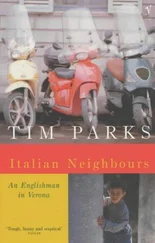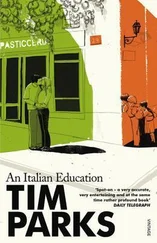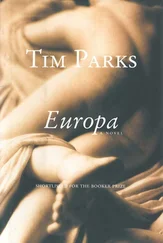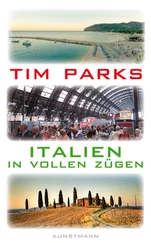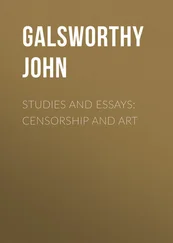So separate currencies guaranteed that despite all the social turmoil, some salutary hierarchical distinctions were maintained. Assessed for tax in 1457, 82 percent of Florentines paid less than a florin and 30 percent nothing at all, because destitute. This monetary apartheid, however, came at the price of some serious accounting problems. Dealing only in florins, Giovanni di Bicci’s bank could use the double-entry system, with debits and credits on opposite pages, Venetian style. But when the family opened a wool-manufacturing business, more primitive methods had to be adopted. Who was to say what the exact relationship between purchases, earnings, and salaries was, when one side of the company dealt in florins, the other in piccioli ? In any event, when business was bad and neither gold nor silver was to be had, the workers were obliged to accept payment in woolen cloth, which they hated, and which messed up the books even further, though it did benefit the pawnbrokers, who had a habit of turning cloth into cash at rates that suited them. However potentially evil money may be, the mind does long for the clarity and convenience of the transferable unit of value.
HOW MUCH WAS the florin worth? A slave girl, or a mule, could be bought for 50 florins. To purchase the piccioli that would pay a maid’s wages for a year might cost 10 florins. Thirty-five florins would pay a year’s rent for a small townhouse with garden, or for the Medici’s banking premises on the corner of via Porta Rossa and via dell’Arte della Lana. Twenty florins would fresco the courtyard of a palazzo costing 1,000 to build, or pay an apprentice boy at the bank for a year, while a barrel of wine would come in at just a lira de piccioli and a visit to the astrologer half that. “Don’t trade in wine,” Cosimo would tell his branch managers, “it’s not worth it.” But he regularly consulted astrologers. Money and magic go together. A leek cost one picciolo and an arm’s length of cheap cloth 9 piccioli , while the same length of gorgeous white damask would set you back 2½ florins, about twenty-five times the price, depending on the exchange rate. In general, luxury goods were expensive — the rich needed their florins — while the staples were cheap, so that, assuming they had been paid, the laborers could get by on their piccioli . But the city’s many wool- and silkworkers were on piece rates and demand was not steady. In hard times, you might be better off as a slave at a rich man’s table.
All the same, despite low wages and separate currencies, the scandal of moneymaking continued, for money will not stay still and the poor are rarely happy with their lot. So if you did manage to lay in a little store of cash, there were laws to prevent you from upsetting others by showing it off. No meal with more than two courses for the common classes. No more than a certain number of guests at any given meal. No clothes with more than one color, unless you are a knight or his lady. Or a magistrate, perhaps. Or a doctor. No fine materials for children. No soft leather soles on your white linen socks. No fur collars. No buttons on women’s clothes except between wrist and elbow, and for maids, none at all. For maids, in fact, no fancy headdress and no high heels, just kerchief and clogs.
The plebs were thus prevented from spending themselves into poverty. A sensible thing surely. Such legislation keeps the natural order natural. Money can’t cause trouble if people aren’t allowed to use it. Was the inspiration behind the laws just a touch misogynist? No doubt the threat of being birched naked through the streets guaranteed a certain frisson when a girl broke the rules and sewed a silver button at her breast.
Sporadically enforced, because in the end bad for business (this was a town that specialized in the production of luxury clothing), the so-called sumptuary laws kept everyone hyperconscious of status. Spying on your neighbors is exciting. Fashions were constantly changing to beat the letter of the law. If such and such a material was banned, then a new one was invented. As in the area of finance, repression proved a great stimulus for creativity, to the detriment of plain speech. This sleeve may look like samite, signora , says the dressmaker, but technically speaking it’s something else. A French invention. Not covered by the legislation. This may look like a row of buttons, but as you see there are no buttonholes, so strictly speaking they are studs.
The legislators worked hard to keep ahead of the game. “Clarification about pearls,” announces one new law. “Clarification about buttons.” “Clarification about the wearing of chains.” But, as for the theologians pondering new financial instruments, the task was endless. “How can we ever curb the disgraceful bestiality of our women?” asks one despairing member of the government. Fashion police were appointed to roam the streets and finger ladies’ clothes. The Officers of the Night, they were called. “Oh, but the collar is suckling, sir, not ermine!” “And what’s suckling?” “An animal, sir.” Meanwhile, Giovanni di Bicci and his two sons wore sober cloaks. They hadn’t yet tackled the problem of how to make their wealth manifest. For the moment, envy was a weed best left unwatered. One of Cosimo’s favorite sayings.
Because the florin was worth a great deal and could not be broken down into smaller coins (otherwise the poor would have begun to use it), bankers found it necessary to invent an accounting currency, so that wholesale prices and discretionary gifts could be calculated in fractions of florins. So the lira a fiorino must rapidly be mentioned. This was worth twenty twenty-ninths of a florin (yes,  ) and each lira a fiorino could be divided into 20 soldi a fiorino , which in turn could be divided into 12 denari a fiorino . Hence there were 348 denari or 29 soldi in a gold florin, though of course there were no such coins as the soldo and the denaro . Who says money and imagination don’t go together? To help them do their sums, each banker was equipped with an abacus. Perhaps not surprisingly, they couldn’t always get their books to balance, despite a thorough knowledge of the rules of double entry. “May God save us in future from greater mistakes,” writes one Medici branch director to the head office, unable to find out where he has gone wrong.
) and each lira a fiorino could be divided into 20 soldi a fiorino , which in turn could be divided into 12 denari a fiorino . Hence there were 348 denari or 29 soldi in a gold florin, though of course there were no such coins as the soldo and the denaro . Who says money and imagination don’t go together? To help them do their sums, each banker was equipped with an abacus. Perhaps not surprisingly, they couldn’t always get their books to balance, despite a thorough knowledge of the rules of double entry. “May God save us in future from greater mistakes,” writes one Medici branch director to the head office, unable to find out where he has gone wrong.
How mysterious these imaginary currencies must have seemed to the uninitiated in a world where everything but the Holy Ghost was visible. Technology had not yet removed the ordinary things of life from view. Piss did not stream into clear water to be sucked away beneath gleaming porcelain. Shit steamed in the pan. If you were a florin kind of person, you could pay a picciolo person to take it away for you and empty it elsewhere. In a back alley, perhaps. The plague victim did not die in starched sheets, nor was his agony alleviated by analgesics. Where there was a perfume, that was because an unpleasant smell was lurking beneath. Your mortality was ever present. People died young.
But there were good smells, too. Packaging hadn’t stretched its shiny film over meats and vegetables, wools and silks. Since windows of oiled cotton didn’t let in much light, the weavers took their looms to the door. The cobblers and saddlers worked their goods in the street. By the Gora Canal, men are washing the raw wool that will soon be on someone’s back. The fishermen come in from the country with carp in their buckets. They pass the barber shaving customers at a corner. The apothecary is grinding nutmeg for cough relief. There are onions for your piles. Everything is present. Every task is clear. That is the natural order: people getting by with the sweat of their brows, as God commanded. Even the feudal lord in the country keeps an army and hires it out, governs his lands. That is understandable. Even the priest helps your soul to paradise when the solid flesh finally melts and the breath rattles its last. Who would deny the need for a church? But what on earth are these bankers doing counting in coins that don’t exist?
Читать дальше
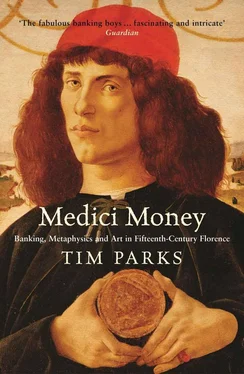
 ) and each lira a fiorino could be divided into 20 soldi a fiorino , which in turn could be divided into 12 denari a fiorino . Hence there were 348 denari or 29 soldi in a gold florin, though of course there were no such coins as the soldo and the denaro . Who says money and imagination don’t go together? To help them do their sums, each banker was equipped with an abacus. Perhaps not surprisingly, they couldn’t always get their books to balance, despite a thorough knowledge of the rules of double entry. “May God save us in future from greater mistakes,” writes one Medici branch director to the head office, unable to find out where he has gone wrong.
) and each lira a fiorino could be divided into 20 soldi a fiorino , which in turn could be divided into 12 denari a fiorino . Hence there were 348 denari or 29 soldi in a gold florin, though of course there were no such coins as the soldo and the denaro . Who says money and imagination don’t go together? To help them do their sums, each banker was equipped with an abacus. Perhaps not surprisingly, they couldn’t always get their books to balance, despite a thorough knowledge of the rules of double entry. “May God save us in future from greater mistakes,” writes one Medici branch director to the head office, unable to find out where he has gone wrong.

